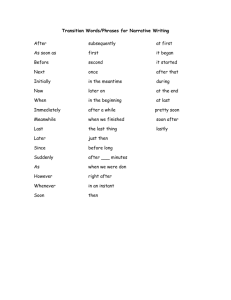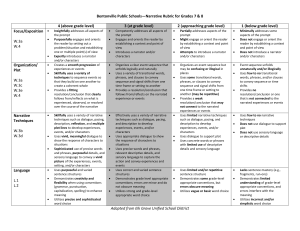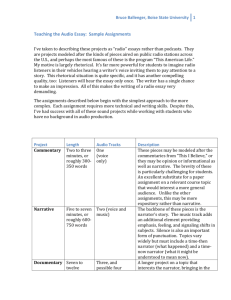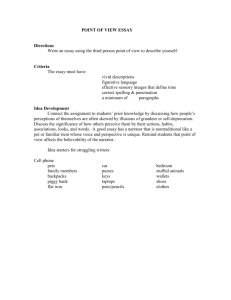Photo Essay: Assignment Sheet & Rubric
advertisement
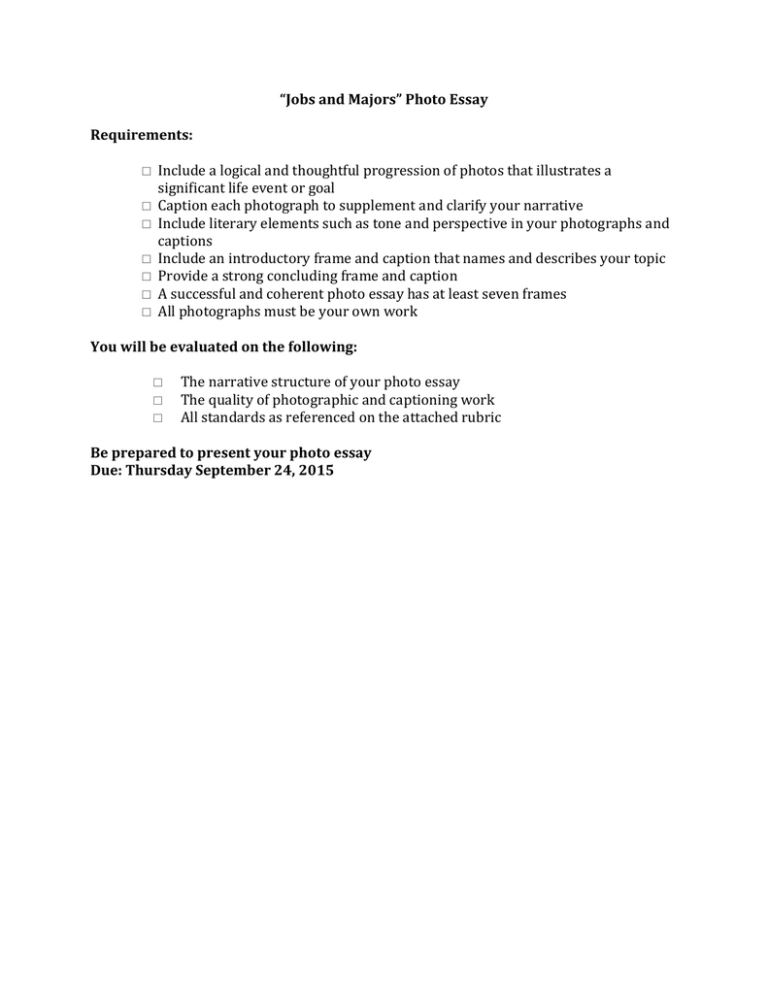
“Jobs and Majors” Photo Essay Requirements: Include a logical and thoughtful progression of photos that illustrates a significant life event or goal Caption each photograph to supplement and clarify your narrative Include literary elements such as tone and perspective in your photographs and captions Include an introductory frame and caption that names and describes your topic Provide a strong concluding frame and caption A successful and coherent photo essay has at least seven frames All photographs must be your own work You will be evaluated on the following: The narrative structure of your photo essay The quality of photographic and captioning work All standards as referenced on the attached rubric Be prepared to present your photo essay Due: Thursday September 24, 2015 Photo Essay Rubric W.11-12.2.D Use precise language, domain-specific vocabulary, and techniques such as metaphor, simile, and analogy to manage the complexity of the topic. Exceeding – 4 Meeting – 3 Approaching - 2 Beginning - 1 No Evidence The text skillfully uses words, phrases, and clauses to link the major sections of the text. The text identifies the relationship between the topic and the examples and/or facts. The text uses words, phrases, and clauses to link the major sections of the text. The text connects the topic and the examples and/or facts. The text contains limited words, phrases, and clauses to link the major sections of the text. The text attempts to connect the topic and the examples and/or facts. The text contains few, if any, words, phrases, and clauses to link the major sections of the text. The text does not connect the topic and the examples and/or facts. The text makes no attempt to link major sections of the text. The text makes no attempt to connect the topic and examples or facts. W.11-12.3.A Engage and orient the reader by setting out a problem, situation, or observation and its significance, establishing one or multiple point(s) of view, and introducing a narrator and/or characters; create a smooth progression of experiences or events Exceeding – 4 Meeting – 3 Approaching - 2 Beginning - 1 No Evidence The text engages and orients the reader by setting out a conflict, situation, or observation and its significance. It establishes one or multiple points of view and introduces a narrator and/or well-developed characters. The text orients the reader by setting out a conflict, situation, or observation and its significance. It establishes one point of view and introduces a narrator and/or developed characters. The text provides a setting with a vague conflict, situation, or observation with an unclear point of view. It introduces a narrator and/or underdeveloped characters. The text provides a setting that is unclear with a vague conflict, situation, or observation. It has an unclear point of view and underdeveloped narrator and/or characters. The text makes no attempt to introduce a setting, narrator, or characters. W.11-12.3.D Use precise words and phrases, telling details, and sensory language to convey a vivid picture of the experiences, events, setting, and/or characters. Exceeding – 4 Meeting – 3 The text uses precise words and phrases, showing details and controlled sensory language and mood to convey a realistic picture of the experiences, events, setting, and/or characters. The text uses words and phrases, telling details and sensory language to convey a vivid picture of the experiences, events, setting, and/or characters. Approaching - 2 Beginning - 1 No Evidence The text uses words and phrases, telling details to convey experiences, events, settings, and/or characters. The text merely tells experiences, events, settings, and/or characters. The text makes no attempt to convery experiences, events, settings, or character. W.11-12.3.F Provide a conclusion that follows from and reflects on what is experienced, observed, or resolved over the course of the narrative. Exceeding – 4 Meeting – 3 Approaching - 2 Beginning - 1 The text builds to a conclusion that logically follows from and reflects on what is experienced, observed, or resolved over the course of the narrative The text builds to a conclusion that follows from and reflects on what is experienced, observed, or resolved over the course of the narrative The text provides a conclusion that follows from what is experienced, observed, or resolved over the course of the narrative. The text may provide a conclusion to the events of the narrative. No Evidence The text makes no attempt to conclude the narrative L.11-12. Demonstrate command of the conventions of standard English grammar and usage when writing or speaking Exceeding – 4 The text demonstrates standard English conventions of usage and mechanics while attending to the norms of the discipline (i.e. MLA, APA, etc.). Meeting – 3 The text presents a formal tone. The text demonstrates standard English conventions of usage and mechanics while attending to the norms of the discipline (i.e. MLA, APA, etc.). Approaching - 2 Beginning - 1 No Evidence The text illustrates a limited awareness of formal tone. The text demonstrates some accuracy in standard English conventions of usage and mechanics. The text illustrates a limited awareness of or inconsistent tone. The text demonstrates inaccuracy in standard English conventions of usage and mechanics. The text makes no attempt at attending to the conventions of standard English.
